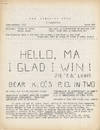
Iulii Caesaris Scaligeri viri clarissimi Poetices libri septem: I. Historicus, II. Hyle, III. Idea, IIII. Parasceue, V. Criticus, VI. Hypercriticus. VII. Epinomis. Ad Sylvium filium. Editio secunda.
by SCALIGER,J.C
- Used
- Hardcover
- Condition
- See description
- Seller
-
AMSTERDAM, Netherlands
Payment Methods Accepted
About This Item
Reviews
(Log in or Create an Account first!)
Details
- Bookseller
- Antiquariaat Fragmenta Selecta
(NL)
- Bookseller's Inventory #
- 155424
- Title
- Iulii Caesaris Scaligeri viri clarissimi Poetices libri septem: I. Historicus, II. Hyle, III. Idea, IIII. Parasceue, V. Criticus, VI. Hypercriticus. VII. Epinomis. Ad Sylvium filium. Editio secunda.
- Author
- SCALIGER,J.C
- Book Condition
- Used
- Binding
- Hardcover
- Keywords
- (Rare Books) Dichtung Greek literature Griechische Literatur Latin literature Poesie Scaliger Swiss imprints antike altertum antiquity poetry römische Literatur
- Bookseller catalogs
- Old and Rare books;
Terms of Sale
Antiquariaat Fragmenta Selecta
Books may be returned for any reason within 14 days of receipt. The book price will be refunded, if the book is returned in the same condition as sent, and packed, shipped and insured as received. A full refund including shipping costs will follow only if an item arrives misdescribed or damaged. Shipping estimates are based on books weighing 4.4 LB or 2 KG. If your book order is heavy or oversized, we will email you to let you know that extra shipping is required. All books are in good antiquarian condition, unless otherwise described. Items offered are subject to prior sale.
About the Seller
Antiquariaat Fragmenta Selecta
About Antiquariaat Fragmenta Selecta
Glossary
Some terminology that may be used in this description includes:
- Calf
- Calf or calf hide is a common form of leather binding. Calf binding is naturally a light brown but there are ways to treat the...
- Leaves
- Very generally, "leaves" refers to the pages of a book, as in the common phrase, "loose-leaf pages." A leaf is a single sheet...
- Gilt
- The decorative application of gold or gold coloring to a portion of a book on the spine, edges of the text block, or an inlay in...
- Edges
- The collective of the top, fore and bottom edges of the text block of the book, being that part of the edges of the pages of a...
- Tail
- The heel of the spine.
- Marbled Paper
- Decorative colored paper that imitates marble with a veined, mottled, or swirling pattern. Commonly used as the end papers or...
- Raised Band(s)
- Raised bands refer to the ridges that protrude slightly from the spine on leather bound books. The bands are created in the...
- Bookplate
- Highly sought after by some collectors, a book plate is an inscribed or decorative device that identifies the owner, or former...
- Spine
- The outer portion of a book which covers the actual binding. The spine usually faces outward when a book is placed on a shelf....
- Device
- Especially for older books, a printer's device refers to an identifying mark, also sometimes called a printer's mark, on the...



